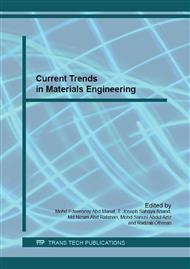p.167
p.172
p.179
p.184
p.189
p.195
p.203
p.208
p.213
The Development and Characterisation of Porous Clay - Precipitated Calcium Carbonate
Abstract:
Ceramic foams, a porous material with a gyroid structures, are becoming highly demanded for various applications such as heat insulation, bone implantation and filtration, because of their unique properties such as high specific surface area, high porosity and low heat transfer rate. In this study, the development of ceramic foam utilised white clay with a combination of precipitated calcium carbonate (PCC). The ceramic foam was successfully developed using this combination after the sample was sintered at 1250 °C for 2 hours holding time. The various compositions of PCC (10.0, 12.5, 15.0, 17.5, 20.0, 22.5 and 25.0 wt.%) affected the chemical composition and compressive strength of the ceramic foam. The chemical composition of ceramic foam was analysed by using X -ray fluorescence (XRF) and the result indicated that the PCC was successfully transformed into calcium oxide (CaO) after the sintering process. The mineralogical composition of the ceramic foam was evaluated using X-ray diffraction (XRD) and has shown the presence of mullite (3Al2O3.2SiO2), gehlenite (Ca2Al2SiO7) and anorthite (2CaAl2Si2O8) after the sintering process. The scanning electron microscope (SEM) analysis showed that the presence of porosity on the strut of the ceramic foam. Meanwhile, the compressive strength of the ceramic foam increased from 0.03 to 1.31 MPa, which is directly proportional to the increased amount of PCC.
Info:
Periodical:
Pages:
189-194
Citation:
Online since:
May 2016
Authors:
Keywords:
Price:
Сopyright:
© 2016 Trans Tech Publications Ltd. All Rights Reserved
Share:
Citation:


